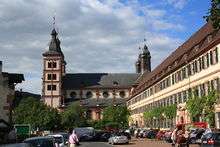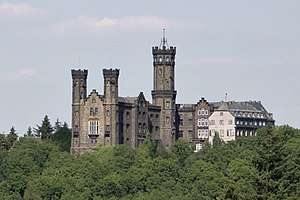Leiningen family
Leiningen is the name of an old German noble family whose lands lay principally in Alsace, Lorraine and the Palatinate. Various branches of this family developed over the centuries and ruled counties with Imperial immediacy.
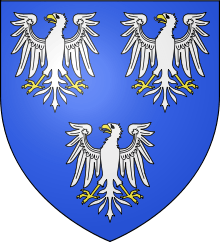
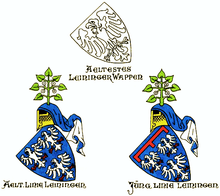
Most of these counties were annexed by the First French Republic in 1793, after French troops conquered the Left Bank of the Rhine during the War of the First Coalition. Several family branches subsequently received secularized abbeys as compensation, but shortly afterwards, these new counties were mediatized and the family lost its immediacy. Today, the only existing branch is that of the Princes of Leiningen.
Origins
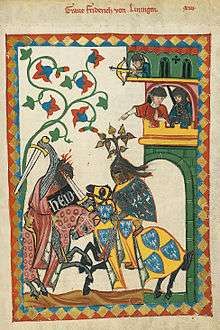
The first count of Leiningen about whom anything definite is known was a certain Emich II (d. before 1138). He (and perhaps his father Emich I) built Leiningen Castle, which is now known as "Old Leiningen Castle" (German: Burg Altleiningen), around 1100 to 1110. Nearby Höningen Abbey was then built around 1120 as the family's burial place.
This family became extinct in the male line when Count Frederick I died about 1220. Frederick I's sister, Liutgarde, married Simon II, Count of Saarbrücken. One of Liutgarde's sons, also named Frederick, inherited the lands of the counts of Leiningen, and he took their arms and their name as Frederick II (d. 1237). He became known as a Minnesinger, and one of his songs was included in the Codex Manesse. Before 1212, he built himself a new castle called Hardenburg, about 10 kilometers south of Altleiningen. This was outside the county of Leiningen on the territory of Limburg Abbey, of which his uncle was the overlord (Vogt), which caused some trouble.
His eldest son, Simon (c. 1204–1234), married Gertrude, heiress of the County of Dagsburg, bringing that property into the family. They had no children and Simon's two brothers inherited the county of Leiningen together: Frederick III (d. 1287) also inherited Dagsburg and Emich IV (d. c. 1276) Landeck Castle; he founded the town of Landau, but the Landeck branch extinguished with his grandson in 1290. Frederick III, who disliked sharing Leiningen castle with his brother, had a new castle built in 1238–41 about 5 kilometres northeast of Leiningen, called Neuleiningen Castle ("New Leiningen"). Frederick III's son, Frederick IV (d. 1316), had two sons, who divided the county into Leiningen-Dagsburg and Leiningen-Hardenburg.
 Hardenburg Castle
Hardenburg Castle- Dagsburg Castle
History
Having increased its possessions, the Leiningen family was divided around 1317 into two branches.
Leiningen-Westerburg
.jpg)
The elder of these, whose head was a landgrave, died out in 1467. Upon this event, its lands fell to a female, the last landgrave's sister Margaret, wife of Reinhard, Lord of Westerburg, and their descendants were known as the family of Leiningen-Westerburg. Later this family was divided into two branches, those of Leiningen-Westerburg-Alt-Leiningen and Leiningen-Westerburg-Neu-Leiningen, both of which are extinct today.
After the French Revolution, the Left Bank of the Rhine was conquered during the War of the First Coalition and annexed by France in 1793. The two counts of Alt- and Neu- Leiningen were arrested and jailed in Paris. They lost their territories. In 1803 they were compensated with secularized Ilbenstadt Abbey (at Niddatal) and Engelthal Abbey. The German mediatization brought an end to these short-lived counties in 1806, when their territories were divided between the Grand Duchy of Berg, the Grand Duchy of Hesse, Nassau-Weilburg and Nassau-Usingen. Ilbenstadt Abbey was sold by the House of Leiningen-Westerburg-Altleiningen in 1921, Engelthal Abbey by the heirs of the House of Leiningen-Westerburg-Neuleiningen in 1952.
Leiningen-Hardenburg
Meanwhile, the younger branch of the Leiningens, known as the family of Leiningen-Hardenburg, was flourishing. On 27 June 1560, this branch was divided into the lines of Leiningen-Dagsburg-Hardenburg, founded by Count Johann Philip (d. 1562), and Leiningen-Dagsburg-Heidesheim or Falkenburg, founded by Count Emicho (d. 1593).
In 1658 Leiningen-Dagsburg-Falkenburg divided into
- Leiningen-Dagsburg (extinct 1706)
- Leiningen-Heidesheim (extinct 1766)
- Leiningen-Guntersblum (extinct 1774)

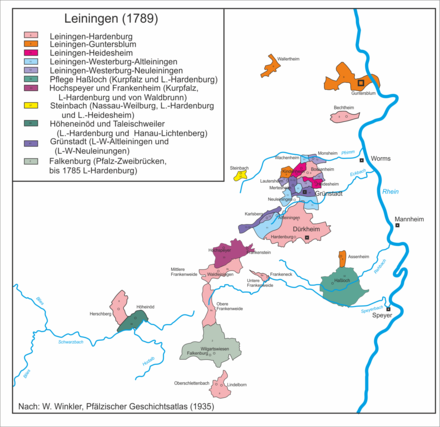
The county of Leiningen-Dagsburg was inherited by Leiningen-Dagsburg-Hardenburg in 1774.
Leiningen-Guntersblum was divided between two further side branches:
- Leiningen-Dagsburg-Falkenburg-Guntersblum, which was deprived of its lands on the left bank of the Rhine by France, but in 1803 received Billigheim as a compensation, then called Leiningen-Billigheim. In 1845 they also acquired Neuburg Castle at Obrigheim. The branch became extinct in 1925.
- Leiningen-Heidesheim, which in 1803 received Neudenau and became known as Leiningen-Neudenau (extinct in 1910).
In 1779, the head of the Leiningen-Dagsburg-Hardenburg line was raised to the rank of a Prince of the Holy Roman Empire with the title of Prince of Leiningen. In 1801, this line was deprived of its lands on the left bank of the Rhine by France, but in 1803 it received Amorbach Abbey as an ample compensation for these losses. A few years later, the Principality of Leiningen at Amorbach was mediatized, and its territory is now included mainly in Baden, but partly in Bavaria and in Hesse. Amorbach Abbey is still today the family seat of the Prince of Leiningen.
The second prince of the Leiningen-Dagsburg-Hardenburg line, Prince Emich Charles, married Princess Victoria of Saxe-Coburg-Saalfeld. After his death in 1814, the princess married Prince Edward, Duke of Kent and Strathearn, a younger son of George III of the United Kingdom, by whom she became the mother of the reigning British Queen Victoria.
Since 1991, the head of the princely line has been Prince Andreas (b. 1955).[1] His eldest brother, Prince Karl Emich was excluded from succession after he married morganatically.
Line of Descent
Note that different sources use different sequence numbers for some of the Counts. For consistency across sources, dates of birth and death are useful.
Earliest Counts
- Emicho of Leiningen helped lead the German Crusade, 1096. His relationship to the others is unclear.[2]
- Emich I was Count of Leiningen in 1127,[3] but it is unclear when he died, or his relation to the other counts.
- Emich II is attested as Count of Leiningen in documents from 1143[4] to 1179[5]
- His son, Friedrich I had taken over the County by 1189[6]
- Emich III is attested as Count of Leiningen in documents from 1193[7] through 1208,[8] though it is unclear his relationship to the previous Counts
- Friedrich I, cousin of Emich III, was recorded as junior count under Emich in 1205,[2] and as count in his own right from 1210[9] to 1217.[10] A document from 1220 refers to his widow.[11]
Saarbrücken Line
- Simon II, Count of Saarbrücken married Liutgarde, the heiress of Leiningen whose descent from the original counts of Leiningen is unclear[12]
- Their son, Friedrich II (d. 1237) inherited the County of Leiningen
- His son, Simon (c. 1204 – 16 Mar 1234) married Gertrude, heiress of the County of Dagsburg, bringing that property into the family.
- Friedrich III, son of Friedrich II, (d. 1287) was attested as count in documents from 1239 and 1249, and married Adelheid of Kyburg
- Their son, Friedrich IV (d. 1316), whose sons divided the County into Leiningen-Dagsburg and Leiningen-Hartenburg.
- Emich IV, brother of Friedrich III (d. c. 1276) ruled a portion of the lands at Leiningen-Landeck
- His son, Emich V (d. 1289), Count of Leiningen-Landeck had no heir.[13]
- Agnes (d. between 1299 and 1303) married Otto I, Count of Nassau
- Their son, Friedrich II (d. 1237) inherited the County of Leiningen
Leiningen-Dagsburg (First Line)
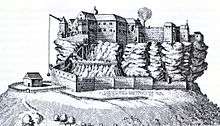
- Friedrich VI (d. 1327), son of Friedrich V, became Count of Leiningen-Dagsburg,[14] today Dagsbourg at Dabo, Moselle, Lorraine (France)
- Friedrich VII, Count of Leiningen-Dagsburg (d. before 1342)
- Friedrich VIII, Count of Leiningen-Dagsburg (1320 – 31 Oct 1387) married Jolanda of Jülich, granddaughter of Gerhard V of Jülich.
- Yolantha (1352 – 24 Apr 1434).[15] Her descendants include the Lords of Egmont and the Dukes of Guelders[16]
- Friedrich IX, Count of Leiningen-Dagsburg[15] (d. 8 Mar 1467)
- Margaret, daughter and only heir of Friedrich IX, Married Reinhard III Lord of Westerburg[14]
- Friedrich VIII, Count of Leiningen-Dagsburg (1320 – 31 Oct 1387) married Jolanda of Jülich, granddaughter of Gerhard V of Jülich.
- Friedrich VII, Count of Leiningen-Dagsburg (d. before 1342)
Leiningen-Westerburg
- Kuno I, Lord of Westerburg (1425–1459), was the son of Margaret of Leiningen and Reinhard of Westerburg
- Reinhard I, Count of Leiningen-Westerburg (1453–1522) inherited the County from his grandmother.[14]
- Kuno II, Count of Leiningen-Westerburg (1487–1547)
- Philipp I, Count of Leiningen-Leiningen (1527–1597)
- George I, Count of Leiningen-Schaumburg (1533–1586)
- Reinhard II, Count of Leiningen-Westerburg (1530–1584)
- Albrecht Philipp, Count of Leiningen-Westerburg (1567–1597)
- Johann Ludwig, Count of Leiningen-Westerburg (1572–1597), last of this branch.
- Kuno II, Count of Leiningen-Westerburg (1487–1547)
- Reinhard I, Count of Leiningen-Westerburg (1453–1522) inherited the County from his grandmother.[14]
This County was then absorbed into Leiningen-Schaumburg.[17]
Leiningen-Leiningen
- Philipp I, Count of Leiningen-Leiningen (1527–1597), son of Kuno II, Count of Leiningen-Westerburg
- Ludwig, Count of Leiningen-Leiningen (1557–1622) married Bernardine of Lippe
- Johann Kasimir, Count of Leiningen-Leiningen (1587–1635)
- Philipp II, Count of Leiningen-Leiningen (1591–1668)
- Ludwig Eberhard, Count of Leiningen-Leiningen (1624–1688) married Charlotte, daughter of William Louis, Count of Nassau-Saarbrücken
- Philipp Ludwig, Count of Leiningen-Leiningen (1652–1705)
- Ludwig Eberhard, Count of Leiningen-Leiningen (1624–1688) married Charlotte, daughter of William Louis, Count of Nassau-Saarbrücken
- Ludwig Emich, Count of Leiningen-Leiningen (1595–1635)
- Johann Ludwig, Count of Leiningen-Leiningen (1625–1665)
- Ludwig, Count of Leiningen-Leiningen (1557–1622) married Bernardine of Lippe
This branch ended in 1705, and this County was also absorbed into Leiningen-Schaumburg.[17]
Leiningen-Schaumburg
- George I, Count of Leiningen-Schaumburg (1533–1586), son of Kuno II, Count of Leiningen-Westerburg
- Philipp Jakob, Count of Leiningen-Schaumburg (1572–1612)
- Reinhard II, Count of Leiningen-Schaumburg (1574–1655)
- Christoph, Count of Leiningen-Schaumburg (1575–1635)
- Margaret Elisabeth (30 June 1604 – 13 August 1667) married Frederick I, Landgrave of Hesse-Homburg
- Philipp Ludwig, Count of Leiningen-Schaumburg (1617–1637)
- George Wilhelm, Count of Leiningen-Schaumburg (1619–1695)[17]
- Johann Anton, Count of Leiningen-Schaumburg (15 Jan 1655 – 2 Oct 1698)
- George Friedrich, Count of Leiningen-Schaumburg (5 Feb 1693 – 6 Oct 1708)
- Christoph Christian, Count of Leiningen-Altleiningen (11 Mar 1656 – 17 May 1728)
- George II Karl Ludwig, Count of Leiningen-Neuleiningen (2 Mar 1666 – 4 Oct 1726)[18]
- Johann Anton, Count of Leiningen-Schaumburg (15 Jan 1655 – 2 Oct 1698)
Leiningen-Westerburg-Altleiningen
- Christoph Christian, Count of Leiningen-Altleiningen (11 Mar 1656 – 17 May 1728), son of George Wilhelm, Count of Leiningen-Schaumburg
- George Hermann, Count of Leiningen-Altleiningen (21 Mar 1679 – 4 Feb 1751)
- Christian Johann, Count of Leiningen-Altleiningen (31 Aug 1730 – 20 Feb 1770)
- Christian Karl, Count of Leiningen-Altleiningen (18 Sep 1757 – 1 Dec 1811)
- Friedrich I Ludwig Christian, Count of Leiningen-Altleiningen (2 Nov 1761 – 9 Aug 1839)
- Friedrich II Eduard, Count of Leiningen-Altleiningen (20 May 1806 – 5 Jun 1868)
- Károly Leiningen-Westerburg
- Johann Ludwig (6 Jun 1807 – 31 Oct 1864)
- Friedrich III Wipprecht Franz, Count of Leiningen-Altleiningen (30 Dec 1852 – 7 Feb 1916)
- Gustav Friedrich Oskar, Count of Leiningen-Altleiningen (8 Feb 1876 – 23 Jul 1929)[18]
- Friedrich III Wipprecht Franz, Count of Leiningen-Altleiningen (30 Dec 1852 – 7 Feb 1916)
- Christian Johann, Count of Leiningen-Altleiningen (31 Aug 1730 – 20 Feb 1770)
- George Hermann, Count of Leiningen-Altleiningen (21 Mar 1679 – 4 Feb 1751)
Leiningen-Westerburg-Neuleiningen
- George II Karl Ludwig, Count of Leiningen-Neuleiningen (2 Mar 1666 – 4 Oct 1726), son of George Wilhelm, Count of Leiningen-Schaumburg
- George Karl I August Ludwig, Count of Leiningen-Neuleiningen (Nassau Line) (17 Feb 1717 – 19 Mar 1787)
- Karl II Gustav Reinhard Waldemar, Count of Leiningen-Neuleiningen (28 Jun 1747 – 7 Jun 1798)
- Ferdinand Karl III, Count of Leiningen-Neuleiningen (8 Sep 1767 – 26 Nov 1813)
- August George Gustav, Count of Leiningen-Neuleiningen (19 Feb 1770 – 9 Oct 1849)
- Christian Franz Seraph Vincenz, Count of Leiningen-Neuleiningen (1810 – 1856)
- Karl II Gustav Reinhard Waldemar, Count of Leiningen-Neuleiningen (28 Jun 1747 – 7 Jun 1798)
- George Ernst Ludwig (Bavaria Line) (3 May 1718 – 24 Dec 1765)
- Karl IV Joseph Philipp Ludwig Ernst, Count of Leiningen-Neuleiningen (13 Aug 1739 – 27 Jul 1797)
- George Karl August, Count of Leiningen-Neuleiningen (27 Aug 1789 – 17 Mar 1865)
- Wilhelm, Count of Leiningen-Neuleiningen (16 Feb 1824 – 29 Apr 1887)[18]
- George Karl August, Count of Leiningen-Neuleiningen (27 Aug 1789 – 17 Mar 1865)
- Karl IV Joseph Philipp Ludwig Ernst, Count of Leiningen-Neuleiningen (13 Aug 1739 – 27 Jul 1797)
- George Karl I August Ludwig, Count of Leiningen-Neuleiningen (Nassau Line) (17 Feb 1717 – 19 Mar 1787)
Leiningen-Hardenburg
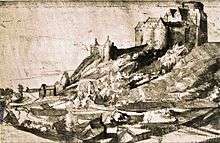

- Gottfried, son of Friedrich V, inherited the portion of Leiningen ruled from Hardenburg
- His son Friedrich married Joan of Rixingen, and their children became Counts of Leiningen-Rixingen, which lasted until 1506
- Gottfried's other son became Emich V, Count of Leiningen-Hardenburg
- Emich VI, Count of Leiningen-Hardenburg (d. 1452) married Beatrix Zähringen, daughter of Bernard I, Margrave of Baden-Baden
- Emich VII, Count of Leiningen-Hardenburg (d. 30 Mar 1495)
- Emich VIII, Count of Leiningen-Hardenburg (d. 18 Feb 1535)[14]
- Katharina (-1585) married Philip II, Count of Nassau-Saarbrücken[15]
- Emich IX, Count of Leiningen-Hardenburg (d. 10 Jan 1541)
- Emich X, Count of Leiningen-Dagsburg (starting the second line in that part of the County) (1540–1593)
- Johann Philipp I, Count of Leiningen-Hardenburg (25 Dec 1539 – 8 Sep 1562)[14]
- Emich XII, Count of Leiningen-Hardenburg (4 Nov 1562 – 24 Nov 1607) married Marie of Wittelsbach, daughter of Wolfgang, Count Palatine of Zweibrücken
- Johann Philipp II, Count of Leiningen-Hardenburg (16 Apr 1588 – 15 Apr 1643) married Elisabeth of Leiningen-Dagsburg, daughter of Emich X.
- Friedrich Emich, Count of Leiningen-Hardenburg (9 Feb 1621 – 26 Jul 1698)
- Marie Polyxena (7 Feb 1662 – 22 Apr 1725) married John Ernst, Count of Nassau-Weilburg[19]
- Emich XIV, Count of Leiningen-Hardenburg (6 Feb 1649 – 12 Dec 1684) married Charlotte Sophie of Baden-Durlach, daughter of Margrave Charles Magnus of Baden-Durlach
- Johann Friedrich, Count of Leiningen-Hardenburg (18 Mar 1661 – 9 Feb 1722) married Katharina of Baden-Durlach, daughter of Frederick VII, Margrave of Baden-Durlach
- Friedrich Magnus, Count of Leiningen-Hardenburg (27 Mar 1703 – 28 Oct 1756)
- Carl Friedrich Wilhelm, 1st Prince of Leiningen (14 Aug 1724 – 9 Jan 1807)[20]
- For descendants, see: Prince of Leiningen
- Carl Friedrich Wilhelm, 1st Prince of Leiningen (14 Aug 1724 – 9 Jan 1807)[20]
- Friedrich Magnus, Count of Leiningen-Hardenburg (27 Mar 1703 – 28 Oct 1756)
- Friedrich Emich, Count of Leiningen-Hardenburg (9 Feb 1621 – 26 Jul 1698)
- Johann Philipp II, Count of Leiningen-Hardenburg (16 Apr 1588 – 15 Apr 1643) married Elisabeth of Leiningen-Dagsburg, daughter of Emich X.
- Emich XII, Count of Leiningen-Hardenburg (4 Nov 1562 – 24 Nov 1607) married Marie of Wittelsbach, daughter of Wolfgang, Count Palatine of Zweibrücken
- Emich VIII, Count of Leiningen-Hardenburg (d. 18 Feb 1535)[14]
- Emich VII, Count of Leiningen-Hardenburg (d. 30 Mar 1495)
- Emich VI, Count of Leiningen-Hardenburg (d. 1452) married Beatrix Zähringen, daughter of Bernard I, Margrave of Baden-Baden
Leiningen-Dagsburg (Second Line)
- Emich X, Count of Leiningen-Dagsburg (1540–1593), son of Emich IX, Count of Leiningen-Hartenburg
- Elisabeth (6 May 1586 – 25 Oct 1623), married her great-nephew Johann Philipp II, Count of Leiningen-Hartenburg
- Philip George, Count of Leiningen-Dagsburg (25 Jul 1582 – 6 Feb 1627)
- Anna (25 May 1625 – 24 Dec 1688) married John, Count of Nassau-Idstein[19]
- Johann Ludwig, Count of Leiningen-Dagsburg-Falkenburg (8 May 1579 – 19 Jun 1625)
- Emich XIII, Count of Leiningen-Dagsburg-Falkenburg (12 Jun 1612 – 1658)
- Juliane Alexandrine married George III, Landgrave of Hesse-Itter and Charles, Landgrave of Hesse-Wanfried
- Emich Christian of Leiningen-Dagsburg (29 March 1642 – 27 April 1702)
- Elisabeth Dorothea Wilhelmine (11 June 1665 – 1722) married Moritz Hermann of Limburg
- George William, Count of Leiningen-Dagsburg-Falkenburg (8 Mar 1636 – 18 Jul 1672)
- John, Count of Leiningen-Dagsburg-Falkenburg (19 Mar 1662 – 13 Nov 1698) married Countess Johanna Magdalene of Hanau-Lichtenberg
- Christian Karl Reinhard of Leiningen-Dachsburg-Falkenburg-Heidesheim (17 Jul 1695 – 17 Nov 1766)
- Countess Caroline Felizitas of Leiningen-Dagsburg (22 May 1734 – 8 May 1810)[20]
- Countess Maria Louise Albertine of Leiningen-Falkenburg-Dagsburg (16 March 1729 – 11 March 1818)
- Christian Karl Reinhard of Leiningen-Dachsburg-Falkenburg-Heidesheim (17 Jul 1695 – 17 Nov 1766)
- John, Count of Leiningen-Dagsburg-Falkenburg (19 Mar 1662 – 13 Nov 1698) married Countess Johanna Magdalene of Hanau-Lichtenberg
- Emich XIII, Count of Leiningen-Dagsburg-Falkenburg (12 Jun 1612 – 1658)
Further historical family seats
_von_Alsheimer_Stra%C3%9Fe_aus_13.7.2009.jpg) Guntersblum Castle
Guntersblum Castle- Neuburg Castle, Obrigheim
- Neudenau Castle
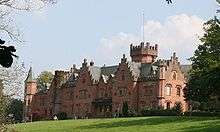 Waldleiningen Castle
Waldleiningen Castle
See also
Notes
- Genealogisches Handbuch des Adels (2004), Volume 133, p. 249, 251.
- Cawley, Charles, FRANCONIA: Toc359858872, Medieval Lands database, Foundation for Medieval Genealogy,
- Simon, J. (1865) Die Geschichte des reichständischen Hauses Ysenburg und Büdingen, Band III Das Ysenburg und Büdingensche Urkundenbuch (Frankfurt) ("Isenburg Urkundenbuch"), III, p. 4.
- Stumpf, K. F. (ed.) (1863) Urkunden zur Geschichte des Erzbisthums Mainz im zwölften Jahrhundert (Acta Maguntina Seculi XII) (Innsbruck) ("Mainz Urkunden 12th Century"), 24, p. 27.
- Brinckmeier (1890), Vol. I, p. 20, quoting charter "im Besitz des Germanischen Museums".
- MGH Diplomata, Tome X, Pars IV, D F I, 993, p. 282.
- Brinckmeier (1890), Vol. I, p. 22, citing Fahne, A. (1866) Geschichte der Grafen zu Salm-Reifferscheidt, Band. I, 2 Abth. p. 48
- Würdtwein, S. A. (1788) Nova Subsidia Diplomatica (Heidelberg), Vol. X, LXXXIX, p. 246
- Stillfried, R. M. von (1843) Monumenta Zollerana, Quellensammlung zur Geschichte des erlauchten Hauses der Grafen von Zollern und Burggrafen von Nürnberg, Erster Theil (Halle) ("Monumenta Zollerana (1843))", XVII, p. 31
- Otterberg, 18 and 19, pp. 16-17
- Brinckmeier (1890), Vol. I, pp. 20 and 41, citing Kremer, J. M. (1779) Origines Nassoicae, Vol. II, p. 261
- Cawley, Charles, FRANCONIA: Liutgarde Leiningen M1 Simon II Saar M2 Lot Wied, Medieval Lands database, Foundation for Medieval Genealogy,
- Cawley, Charles, FRANCONIA: Friedrich III Leiningen died 1287, Medieval Lands database, Foundation for Medieval Genealogy,
-

- Marek, Miroslav. "leiningen/leiningen3.html". genealogy.euweb.cz.
- Lundy, Darryl. "Friedrich VII Graf von Leiningen-Dagsbur". The Peerage. p. 4298 § 42975.
- Marek, Miroslav. "runkel/runkel2.html". genealogy.euweb.cz.
- Marek, Miroslav. "runkel/runkel3.html". genealogy.euweb.cz.
- Lundy, Darryl. "Marie Polyxena Gräfin von Leiningen-Hardenburg". The Peerage. p. 11322 § 113217.
- Marek, Miroslav. "leiningen/leiningen4.html". genealogy.euweb.cz.
References
- Toussaint, Ingo (1982). Die Grafen von Leiningen. Sigmaringen: Jan Thorbecke Verlag. ISBN 3-7995-7017-9.
Attribution

- Brinckmeier (1890–1891). Genealogische Geschichte des Hauses Leiningen. Brunswick.
External links
| Wikimedia Commons has media related to House of Leiningen. |
